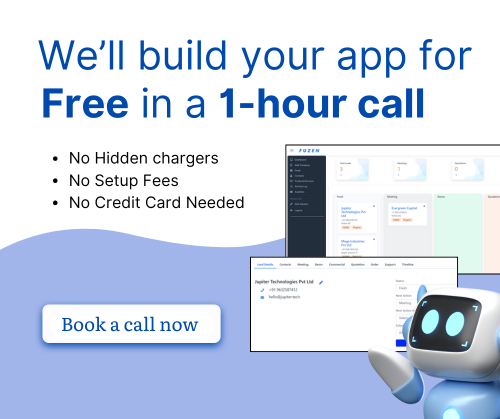Starting a SaaS (Software as a Service) business can be a lucrative and rewarding venture, but it also requires a lot of planning, hard work, and dedication. If you're a beginner looking to get started in the world of SaaS, here's a guide to help you get started.
But can you start a SaaS business without any technical expertise? Let's understand that first.
Is it possible to start a SaaS company without technical expertise?
Absolutely! Starting a SaaS (Software as a Service) company without tech know-how is possible. Look at Canva—these folks cracked it big! Canva revolutionized design for non-designers. Melanie Perkins, the CEO, didn’t kick off as a coding genius. She spotted a gap, collaborated with tech-savvy folks, and brought her vision to life.
In today's landscape, you don't even have to find tech-savvy people. Just a perfect no-code SaaS builder is enough.
The trick is simply to understand your concept, find the right tool to build it, and work hard to spread the word. It’s all about networking, locating the best talent, and being the driving force behind the idea’s progress.
How to start a SaaS company?
1. Identify a need or problem in the market
The first step in starting any business is to find ideas for your SaaS business. To do so you need to identify a need or problem in the market that you can solve.
For starting a SaaS company, this means finding a software solution that will solve a specific problem or meet a specific need for your target audience.
To do this, you'll need to conduct market research to understand the needs and pain points of your potential customers. This can involve surveying potential customers, speaking with industry experts, and analyzing market trends.
2. Develop a product roadmap
Once you've identified a need or problem in the market, the next step is to validate your idea and develop a product roadmap. This is a document that outlines the steps you'll take to develop and launch your SaaS product. It should include a timeline of when each step will be completed and what resources you'll need to complete them.
Clear structure is everything when you're building a product from scratch. At Wave Connect, we started with a detailed visual product roadmap outlining each development milestone, key features, and team responsibilities.
That clarity allowed us to cut our initial build time by 30%, avoid redundant work, and launch a usable beta within 10 weeks. It also helped us align priorities with stakeholders early on, which significantly reduced post-launch revisions and improved team velocity.
3. Build a minimum viable product (MVP)
Before you spend a lot of time and resources developing a full-featured SaaS product, it's important to build a minimum viable product (MVP). An MVP is a stripped-down version of your product that includes only the core features needed to solve the problem or meet the needs of your target audience.
This will allow you to test your product idea with a small group of users and gather feedback to improve it before launching it to the wider market.
4. Test and validate your product
Before launching your SaaS product, it's important to test and validate it to ensure it meets the needs of your target audience and is ready for the market. This can involve conducting user testing to gather feedback on the product, as well as running beta tests with a small group of users.
This will help you identify any issues or bugs and make necessary changes before launching your product to the wider market.
5. Launch and market your product
Once your product is tested and validated, it's time to launch it to the wider market.
This will involve creating a marketing plan to promote your product and reach potential customers. This can include creating a website, social media presence, running email campaigns and running paid advertising campaigns.
It's also important to establish a pricing model for your product and create a sales strategy to generate revenue.
6. Support and maintain your product
After launching your SaaS product, it's important to continue supporting and maintaining it to ensure it meets the needs of your customers and stays up-to-date.
This can involve adding new features and functionality, fixing bugs and issues, and providing customer support. It's also important to continually gather feedback from your customers to improve and evolve your product over time.
Mistakes to avoid when starting a SaaS company
Starting a SaaS (Software as a Service) company can be incredibly rewarding, but it's also fraught with challenges. Here are some common mistakes to avoid
Ignoring market research
Without thorough market research, you risk building a product that nobody wants or needs. Understanding your target audience, their pain points, and the competitive landscape is crucial for shaping your product and marketing strategy.
Building too much too soon
Building a feature-rich product from the start can lead to unnecessary complexity and development costs. It's better to start with a minimum viable product (MVP) that addresses the core problem and gather feedback from users to guide future development.
Underestimating costs
SaaS businesses often require significant upfront investment in development, marketing, and infrastructure. Underestimating costs can lead to financial strain or even failure. It's essential to create a realistic budget and plan for contingencies.
Neglecting customer feedback
Your customers are the ultimate judges of your product's value. Neglecting their feedback can result in missed opportunities for improvement and innovation. Actively soliciting and acting upon customer feedback is critical for building a successful SaaS company.
Poor user onboarding
First impressions matter, especially in the competitive SaaS market. If users struggle to onboard onto your platform or understand how to use it, they're likely to abandon it in favor of competitors with better user experiences.
Lack of scalability
As your SaaS company grows, your infrastructure and architecture must be able to handle increased demand. Failure to plan for scalability can result in downtime, poor performance, and ultimately, loss of customers.
Ignoring customer acquisition costs
Acquiring customers can be expensive, but it's essential to ensure that the cost of acquiring a customer (CAC) doesn't exceed the customer's lifetime value (CLV). Ignoring CAC can lead to unsustainable growth and financial difficulties.
Ignoring churn
High churn rates can indicate underlying issues with your product or customer service. Ignoring churn can result in a shrinking customer base and hinder your ability to achieve sustainable growth. It's crucial to prioritize customer retention efforts to minimize churn.
Poor marketing and sales strategy
Even the best product won't succeed if nobody knows about it. A lack of effective marketing and sales strategy can result in low visibility, fewer leads, and poor conversion rates. Investing in marketing and sales efforts is essential for driving customer acquisition and revenue growth.
Neglecting legal and compliance issues
Ignoring legal and compliance issues can have serious consequences for your SaaS company, including costly fines, legal battles, and reputational damage. It's crucial to stay informed about relevant regulations and ensure compliance from the outset.
Failing to adapt
The SaaS landscape is constantly evolving, with new technologies, trends, and competitors emerging regularly. Failing to adapt to changes in the market can result in obsolescence or being overtaken by more agile competitors. Continuous innovation and adaptation are key to long-term success in the SaaS industry.
Conclusion
It can be challenging and rewarding to start a SaaS company, but with careful planning and hard work, it can be a successful and lucrative business.
By following these steps and staying focused on meeting the needs of your target audience, you can start a successful SaaS company.
FAQs
Q. How do I validate my SaaS idea?
Validate your SaaS idea by conducting market research, gathering feedback from potential users, building prototypes or MVPs (Minimum Viable Products), and analyzing competitors in the industry.
Q. How can I find technical co-founders or developers for my SaaS company?
Networking events, tech meetups, startup incubators, and online platforms like GitHub, Stack Overflow, or co-founder matching websites can help you connect with potential technical partners or developers.
Q. What are the essential things to consider legally when starting a SaaS business?
Important legal aspects include forming a business entity, protecting intellectual property rights, drafting clear terms of service and privacy policies, complying with data protection regulations, and considering any necessary licenses or permits.
Q. How can I fund my SaaS startup?
Funding options include bootstrapping, seeking investments from angel investors, venture capitalists, crowdfunding platforms, or applying for startup accelerators or incubators.
Q. How do I acquire initial users for my SaaS product?
Utilize early adopters, offer free trials or beta versions, leverage content marketing, social media, SEO strategies, and consider referral programs to attract and retain initial users.
Q. What metrics should I track to measure the success of my SaaS company?
Key metrics include Monthly Recurring Revenue (MRR), Customer Acquisition Cost (CAC), Churn Rate, Customer Lifetime Value (CLV), and Net Promoter Score (NPS) among others.
Q. How important is customer feedback in building a successful SaaS product?
Customer feedback is crucial for continuous improvement. It helps in understanding user needs, identifying pain points, and guiding product development to ensure it meets customer expectations.
Q. What are the common challenges faced in running a SaaS business?
Challenges may include fierce competition, staying updated with technological advancements, ensuring data security, scaling effectively, maintaining consistent revenue growth, and adapting to evolving customer needs.

Pushkar is a seasoned SaaS entrepreneur. A graduate from IIT Bombay, Pushkar has been building and scaling SaaS / micro SaaS ventures since early 2010s. When he witnesses the struggle of non technical micro SaaS entrepreneurs first hand, he decided to build Fuzen as a nocode solution to help these micro SaaS builders.


